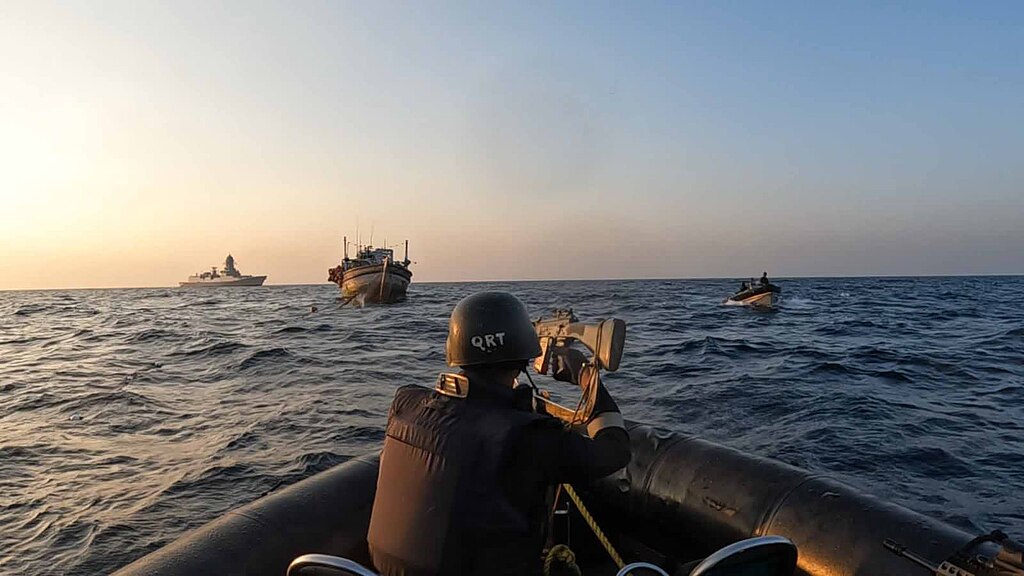
The Indian Navy has been deployed in in the Indian Ocean, Arabian Sea, and Gulf of Aden, but the former is increasingly seeing competition with China.
“Modi government’s strategy [is] to use [Indian] island territories to project power in the Indo-Pacific in support of maritime security of the region.”
As China seeks to gain more prominence in the Indian Ocean, India is pushing back with a number of its own efforts to sustain its sphere of influence. According to the excerpted article from the Indian nationalist publication Hindustan Times, Indian Defence Minister Rajnath Singh recently announced the inauguration of naval bases, which will be on islands in the Indian territory of the Lakshadweep archipelago, near the states of the Maldives and Sri Lanka. The article describes the bases as a “game-changer” and notes how they are part of a broader strategy of the Modi administration to project power into the Indo-Pacific. Specifically, according to the article, India seeks to counter the Chinese Navy and make it “think twice” about hostile actions towards India.
India considers China’s “String of Pearls” strategy in the Indian Ocean as an attempt to encircle and contain India, including with Chinese naval bases in Cambodia, Sri Lanka, [i] and Pakistan and a port in Myanmar, which can be converted to a base in the future. China can use naval bases to monitor India’s Navy and naval training exercises and, in the event of war, strike Indian ships capable of firing nuclear weapons, which would limit India’s nuclear deterrent.[ii] China claims that India is exaggerating the threat from China and is interfering in the sovereignty of India’s neighbors in the Indian Ocean, such as Sri Lanka and the Maldives, by pressuring them to disallow even Chinese “scientific research vessels”[iii] to dock at their ports.[iv] However, India disregards China’s claims. Rather, to meet the threat India perceives from China, the least India can do is to increase own naval bases to match, if not necessarily even exceed, the Chinese port and base presence in the Indian Ocean. India considers the Indian Ocean its own sphere of influence and is, therefore, building up its naval infrastructure to meet its security needs.
Sources:
“India to build naval bases in Agatti and Minicoy Islands,” Hindustan Times (Delhi-based weekly covering issues in India and around the world from nationalist angles),14 January 2024. hindustantimes.com/india-news/india-to-build-naval-bases-in-agatti-and-minicoy-islands-101707884042309.html
After Prime Minister Narendra Modi’s visit to Lakshadweep, India has decided to firmly extend its naval footprint by establishing naval bases in Agatti and Minicoy Islands along with air bases in order to secure the vital sea lanes of communication.
This decision dovetails into Modi government’s strategy to use its islands territories to project power in the Indo-Pacific in support of maritime security of the region. The geographical location of Lakshadweep and Minicoy Islands and the Andamans and Nicobar Islands is such that India can safeguard the maritime trade routes while countering the challenge of rapidly expanding Chinese Navy and their supplicants in the Indian Ocean…. Such level of force projection has never been seen in the past and will make the adversary [China] and its supplicants think twice before playing mischief in the Indian Ocean region.
Notes:
[i] An overlooked reason why China has gained increasing influence in Sri Lanka is that India’s domestic Tamil population has exerted pressure on India’s government to pressure the Sri Lankan government on treating Tamil civilians better during the civil war and in Sri Lanka. Although India did not directly intervene, it “warned” Sri Lanka about its human rights conduct, while the U.S suspended aid to Sri Lanka for its human rights violations. China, in contrast, took advantage of the situation to offer crucial aid, armaments, and diplomatic support to the Sri Lankan government without any criticism of its human rights record. See A. Jathindra, “Revisiting Sri Lanka’s Foreign Policy Balance under the Shadow of the Space Dragon,” Journal of Indo-Pacific Affairs, July-August 2023. https://media.defense.gov/2023/Jul/28/2003270082/-1/-1/1/JATHINDRA_COMMENTARY.PDF
[ii] See, for example, Firstpost.com, “’String of Pearls’: How China-made Kyaukphyu Port in Myanmar threatens India’s nuclear attack submarine base,” 8 January 2024, https://www.firstpost.com/world/string-of-pearls-how-china-made-kyaukphyu-port-in-myanmar-threatens-indias-nuclear-attack-submarine-base-13588512.html.
[iii] The Washington D.C-based think tank, Center for Strategic and International Studies (CSIS), from 2020 to 2024, 64 Chinese “oceanographic missions” using “research vessels” were observed from satellite imagery, and 80% of them “demonstrated suspect behavior or possessed organizational links suggesting their involvement in advancing Beijing’s geopolitical agenda.” Indis would, therefore, rightly be suspicious of their activities in the Indian Ocean. See “China’s Research Vessels Carry Out Covert Missions for PLA,” The Maritime Executive, 14 January 2024. https://maritime-executive.com/article/study-china-s-research-vessels-carry-out-covert-missions-for-pla
[iv] See, for example, “印度海军潜艇到访斯里兰卡,印媒炒作“击败中国 (Indian navy submarine visits Sri Lanka, and Indian media exaggerates defeating China),” guancha.cn (privately owned Chinese-language website with nationalist tendencies), 5 February 2024. https://www.guancha.cn/internation/2024_02_05_724626.shtml
Image: The Indian Navy has been deployed in in the Indian Ocean, Arabian Sea, and Gulf of Aden, but the former is increasingly seeing competition with China
Source: Government of India https://commons.wikimedia.org/wiki/File:Indian_Navy_QRT_deployed_in_North,_Central_Arabian_Sea_and_Gulf_of_Aden.jpg
Attribution: CC x 2.0
